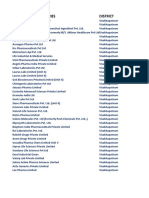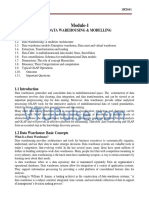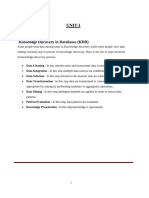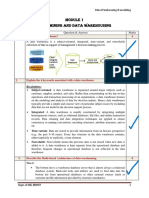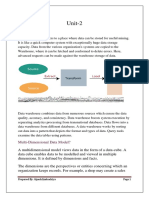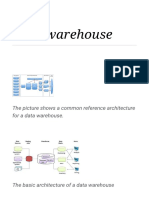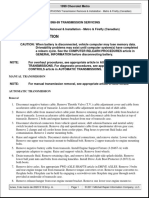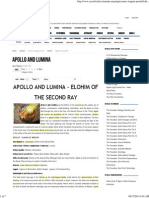DM Module 1
Uploaded by
hibariseijiDM Module 1
Uploaded by
hibariseijiData Mining and Data Warehousing (18CS641) Module 1- Data Warehousing & modeling
MODULE 1: DATA WAREHOUSING & MODELING
Data warehouses generalize and consolidate data in multidimensional space. The construction of data
warehouses involves data cleaning, data integration, and data transformation, and can be viewed as an
important preprocessing step for data mining. Moreover, data warehouses provide online analytical
processing (OLAP) tools for the interactive analysis of multidimensional data of varied granularities,
which facilitates effective data generalization and data mining.
Many other data mining functions, such as association, classification, prediction, and clustering, can be
integrated with OLAP operations to enhance interactive mining of knowledge at multiple levels of
abstraction. Hence, the data warehouse has become an increasingly important platform for data analysis
and OLAP and will provide an effective platform for datamining. Therefore, data warehousing and
OLAP form an essential step in the knowledge discovery process.
1.1 Data Warehouse: Basic Concepts
1.1.1 What Is a Data Warehouse?
Data warehousing provides architectures and tools for business executives to systematically organize,
understand, and use their data to make strategic decisions. Data warehouse systems are valuable tools in
today’s competitive, fast-evolving world. In the last several years, many firms have spent millions of
dollars in building enterprise-wide data warehouses. Many people feel that with competition mounting
in every industry, data warehousing is the latest must-have marketing weapon—a way to retain
customers by learning more about their needs.
A data warehouse refers to a data repository that is maintained separately from an organization’s
operational databases. Data warehouse systems allow for integration of a variety of application systems.
They support information processing by providing a solid platform of consolidated historic data for
analysis.
According to William H. Inmon, a leading architect in the construction of data warehouse systems, “A
data warehouse is a subject-oriented, integrated, time-variant, and nonvolatile collection of data in
support of management’s decision making process”.
Dept of CSE, Vemana I.T Page 1 of 16
Data Mining and Data Warehousing (18CS641) Module 1- Data Warehousing & modeling
Key features:
Subject-Oriented: A data warehouse can be used to analyze a particular subject area. For
example, "sales" can be a particular subject.
Integrated: A data warehouse integrates data from multiple data sources. For example, source
A and source B may have different ways of identifying a product, but in a data warehouse, there
will be only a single way of identifying a product.
Time-Variant: Historical data is kept in a data warehouse. For example, one can retrieve data
from 3 months, 6 months, 12 months, or even older data from a data warehouse. This contrasts
with a transactions system, where often only the most recent data is kept. For example, a
transaction system may hold the most recent address of a customer, where a data warehouse can
hold all addresses associated with a customer.
Non-volatile: Once data is in the data warehouse, it will not change. So, historical data in a data
warehouse should never be altered.
1.1.2 Differences between Operational Database Systems and Data Warehouses
The major task of online operational database systems is to perform online transaction and query
processing. These systems are called online transaction processing (OLTP) systems. They cover most
of the day-to-day operations of an organization such as purchasing, inventory, manufacturing, banking,
payroll, registration, and accounting.
Data warehouse systems, on the other hand, serve users or knowledge workers in the role of data analysis
and decision making. Such systems can organize and present data in various formats in order to
accommodate the diverse needs of different users. These systems are known as online analytical
processing(OLAP) systems. The major distinguishing features of OLTP and OLAP are summarized as
follows:
Dept of CSE, Vemana I.T Page 2 of 16
Data Mining and Data Warehousing (18CS641) Module 1- Data Warehousing & modeling
1.1.3 Data Warehousing: A Multitiered Architecture
Tier-1:
The bottom tier is a warehouse database server that is almost always a relational database system.
Back-end tools and utilities are used to feed data into the bottom tier from operational databases
or other external sources (such as customer profile information provided by external consultants).
These tools and utilities perform data extraction, cleaning, and transformation (e.g., to merge
similar data from different sources into a unified format), as well as load and refresh functions to
update the data warehouse . The data are extracted using application program interfaces known
as gateways. A gateway is supported by the underlying DBMS and allows client programs to
generate SQL code to be executed at a server.
Examples of gateways include ODBC (Open Database Connection) and OLEDB (Open Linking
and Embedding for Databases) by Microsoft and JDBC (Java Database Connection).
This tier also contains a metadata repository, which stores information about the data warehouse
and its contents.
Dept of CSE, Vemana I.T Page 3 of 16
Data Mining and Data Warehousing (18CS641) Module 1- Data Warehousing & modeling
Figure 1: A Three Tier Data Warehouse Architecture
Tier-2:
The middle tier is an OLAP server that is typically implemented using either a relational OLAP
(ROLAP) model or a multidimensional OLAP.
• OLAP model is an extended relational DBMS thatmaps operations on multidimensional data
to standard relational operations.
• A multidimensional OLAP (MOLAP) model, that is, a special-purpose server that directly
implements multidimensional data and operations.
Tier-3:
The top tier is a front-end client layer, which contains query and reporting tools, analysis tools, and/or
data mining tools (e.g., trend analysis, prediction, and so on).
Dept of CSE, Vemana I.T Page 4 of 16
Data Mining and Data Warehousing (18CS641) Module 1- Data Warehousing & modeling
1.1.4 Data Warehouse Models:
There are three data warehouse models.
1. Enterprise warehouse:
• An enterprise warehouse collects all of the information about subjects spanning the entire
organization.
• It provides corporate-wide data integration, usually from one or more operational systems or
external information providers, and is cross-functional in scope.
• It typically contains detailed data as well as summarized data, and can range in size from a few
gigabytes to hundreds of gigabytes, terabytes, or beyond.
• An enterprise data warehouse may be implemented on traditional mainframes, computer super
servers, or parallel architecture platforms. It requires extensive business modeling and may take
years to design and build.
2. Data mart:
• A data mart contains a subset of corporate-wide data that is of value to a specific group of users.
The scope is confined to specific selected subjects. For example, a marketing data mart may
confine its subjects to customer, item, and sales. The data contained in data marts tend to be
summarized.
• Data marts are usually implemented on low-cost departmental servers that are UNIX/LINUX- or
Windows-based. The implementation cycle of a data mart is more likely to be measured in weeks
rather than months or years. However, it may involve complex integration in the long run if its
design and planning were not enterprise-wide.
Depending on the source of data, data marts can be categorized as independent or dependent.
Independent data marts are sourced from data captured from one or more operational systems or
external information providers, or from data generated locally within a particular department or
geographic area. Dependent data marts are sourced directly from enterprise data warehouses.
3. Virtual warehouse:
• A virtual warehouse is a set of views over operational databases. For efficient query processing,
only some of the possible summary views may be materialized.
• A virtual warehouse is easy to build but requires excess capacity on operational database servers.
Dept of CSE, Vemana I.T Page 5 of 16
Data Mining and Data Warehousing (18CS641) Module 1- Data Warehousing & modeling
Figure : A recommended approach for data warehouse development
1.1.5 Extraction, Transformation, and Loading
Data warehouse systems use back-end tools and utilities to populate and refresh their data . These tools
and utilities include the following functions:
Data extraction, which typically gathers data from multiple, heterogeneous, and external sources.
Data cleaning, which detects errors in the data and rectifies them when possible.
Data transformation, which converts data from legacy or host format to warehouse format.
Load, which sorts, summarizes, consolidates, computes views, checks integrity, and builds indices
and partitions.
Refresh, which propagates the updates from the data sources to the warehouse.
Dept of CSE, Vemana I.T Page 6 of 16
Data Mining and Data Warehousing (18CS641) Module 1- Data Warehousing & modeling
1.1.6 Meta Data Repository:
Metadata are data about data. When used in a data warehouse, metadata are the data that define
warehouse objects. Metadata are created for the data names and definitions of the given warehouse.
Additional metadata are created and captured for timestamping any extracted data, the source of the
extracted data, and missing fields that have been added by data cleaning or integration processes.
A metadata repository should contain the following:
• A description of the structure of the data warehouse, which includes the warehouse schema,
view, dimensions, hierarchies, and derived data definitions, as well as data mart locations and
contents.
• Operational metadata, which include data lineage (history of migrated data and the sequence of
transformations applied to it), currency of data (active, archived, or purged), and monitoring
information (warehouse usage statistics, error reports, and audit trails).
• The algorithms used for summarization, which include measure and dimension definition
algorithms, data on granularity, partitions, subject areas, aggregation, summarization, and
predefined queries and reports.
• The mapping from the operational environment to the data warehouse, which includes source
databases and their contents, gateway descriptions, data partitions, data extraction, cleaning,
transformation rules and defaults, data refresh and purging rules, and security (user
authorization and access control).
• Data related to system performance, which include indices and profiles that improve data
access and retrieval performance, in addition to rules for the timing and scheduling of refresh,
update, and replication cycles.
• Business metadata, which include business terms and definitions, data ownership information,
and charging policies.
1.2 Data Warehouse Modelling: Data Cube and OLAP
Data warehouses and OLAP tools are based on a multidimensional data model. This model views
data in the form of a data cube.
1.2.1 Data Cube: A multidimensional Data model
• A data cube, such as sales, allows data to be modeled and viewed in multiple dimensions
• Dimension tables, such as item (item_name, brand, type), or time (day, week, month, quarter,
year)
Dept of CSE, Vemana I.T Page 7 of 16
Data Mining and Data Warehousing (18CS641) Module 1- Data Warehousing & modeling
• Fact table contains measures (such as dollars_sold) and keys to each of the related dimension
tables
• In data warehousing literature, an n-D base cube is called a base cuboid. The top most 0-D
cuboid, which holds the highest-level of summarization, is called the apex cuboid. The lattice
of cuboids forms a data cube.
Given a set of dimensions, we can generate a cuboid for each of the possible subsets of the given
dimensions. The result would form a lattice of cuboids, each showing the data at a different level of
summarization, or group-by. The lattice of cuboids is then referred to as a data cube. Figure shows a
lattice of cuboids forming a data cube for the dimensions time, item, location, and supplier. The cuboid
that holds the lowest level of summarization is called the base cuboid.
Dept of CSE, Vemana I.T Page 8 of 16
Data Mining and Data Warehousing (18CS641) Module 1- Data Warehousing & modeling
1.2.2 Stars, Snowflakes, and Fact Constellations: Schemas for Multidimensional Data Models
The most popular data model for a data warehouse is a multidimensional model, which can exist
in the form of a star schema, a snow flake schema, or a fact constellation schema.
Schemas for multidimensional data models
• Star schema: A fact table in the middle connected to a set of dimension tables
• Snowflake schema: A refinement of star schema where some dimensional hierarchy is
normalized into a set of smaller dimension tables, forming a shape similar to snowflake
• Fact constellations: Multiple fact tables share dimension tables, viewed as a collection of
stars, therefore called galaxy schema or fact constellation
Star schema: The most common modeling paradigm is the star schema, in which the data warehouse
contains (1) a large central table (fact table) containing the bulk of the data, with no redundancy, and (2)
a set of smaller attendant tables (dimension tables), one for each dimension. The schema graph resembles
a starburst, with the dimension tables displayed in a radial pattern around the central fact table.
Dept of CSE, Vemana I.T Page 9 of 16
Data Mining and Data Warehousing (18CS641) Module 1- Data Warehousing & modeling
Snowflake schema: The snowflake schema is a variant of the star schema model, where some dimension
tables are normalized, thereby further splitting the data into additional tables. The resulting schema graph
forms a shape similar to a snowflake.
Fact constellation: Sophisticated applications may require multiple fact tables to share dimension tables.
This kind of schema can be viewed as a collection of stars, and hence is called a galaxy schema or a fact
constellation.
Dept of CSE, Vemana I.T Page 10 of 16
Data Mining and Data Warehousing (18CS641) Module 1- Data Warehousing & modeling
1.2.3 Dimensions: The Role of Concept Hierarchies
A concept hierarchy defines a sequence of mappings from a set of low-level concepts to higher-level,
more general concepts. Consider a concept hierarchy for the dimension location. City values for
location include Vancouver, Toronto, New York, and Chicago. Each city, however, can be mapped to
the province or state to which it belongs
For example, suppose that the dimension location is described by the attributes number, street, city,
province or state, zip code, and country. These attributes are related by a total order, forming a concept
hierarchy such as “street < city < province or state < country.” This hierarchy is shown in Figure
Dept of CSE, Vemana I.T Page 11 of 16
Data Mining and Data Warehousing (18CS641) Module 1- Data Warehousing & modeling
1.2.4 Measures: Their Categorization and Computation
• Distributive: if the result derived by applying the function to n aggregate values is the same as
that derived by applying the function on all the data without partitioning
E.g., count(), sum(), min(), max()
• Algebraic: if it can be computed by an algebraic function with M arguments (where M is a
bounded integer), each of which is obtained by applying a distributive aggregate function
E.g., avg(), min_N(), standard_deviation()
• Holistic: if there is no constant bound on the storage size needed to describe a subaggregate.
E.g., median(), mode(), rank()
Dept of CSE, Vemana I.T Page 12 of 16
Data Mining and Data Warehousing (18CS641) Module 1- Data Warehousing & modeling
1.2.5 Typical OLAP Operations
• ROLL-UP
This is like zooming-out on the data-cube This is required when the user needs further abstraction
or less detail.
• Initially, the location-hierarchy was "street < city < province < country".
• On rolling up, the data is aggregated by ascending the location-hierarchy from the level-of city
to level-of-country.
• DRILL DOWN
This is like zooming-in on the data. This is the reverse of roll-up.
• This is an appropriate operation → when the user needs further details or → when the user
wants to partition more finely or → when the user wants to focus on some particular values of
certain dimensions.
• This adds more details to the data.
• Initially, the time-hierarchy was "day < month < quarter < year”.
• On drill-up, the time dimension is descended from the level-of-quarter to the level-of-month
• PIVOT (OR ROTATE)
• This is used when the user wishes to re-orient the view of the data-cube. This may involve →
swapping the rows and columns or → moving one of the row-dimensions into the column-
dimension.
• SLICE & DICE
These are operations for browsing the data in the cube.
• These operations allow ability to look at information from different viewpoints.
• A slice is a subset of cube corresponding to a single value for 1 or more members of dimensions.
A dice operation is done by performing a selection of 2 or more dimensions.
Dept of CSE, Vemana I.T Page 13 of 16
Data Mining and Data Warehousing (18CS641) Module 1- Data Warehousing & modeling
What is ODS? How does it differ from data-warehouse? Explain.
ODS (OPERATIONAL DATA STORE)
• ODS is defined as a subject-oriented, integrated, volatile, current-valued data store,
containing only corporate-detailed data.
→ ODS is subject-oriented i.e it is organized around main data-subjects of the company
→ ODS is integrated i.e. it is a collection of data from a variety of systems.
→ ODS is volatile i.e. data changes frequently, as new information refreshes ODS.
→ ODS is current-valued i.e it is up-to-date & reflects the current-status of information.
→ ODS is detailed i.e. it is detailed enough to serve needs of manager.
Dept of CSE, Vemana I.T Page 14 of 16
Data Mining and Data Warehousing (18CS641) Module 1- Data Warehousing & modeling
Why multidimensional views of data and data-cubes are used?
Ans:
• Data-cube refers to multi-dimensional array of data.
• The data-cube is used to represent data along some measure-of-interest.
• Data-cubes allow us to look at complex data in a simple format.
• For ex (Fig 2.1a): A company might summarize financial-data to compare sales
i) by product
ii) by date &
iii) by country.
Explain the characteristics of ODS. (06 Marks)
Ans:
ODS (OPERATIONAL DATA STORE)
• ODS is defined as a subject-oriented, integrated, volatile, current-valued data store,
containing only corporate-detailed data.
→ ODS is subject-oriented i.e it is organized around main data-subjects of the company
→ ODS is integrated i.e. it is a collection of data from a variety of systems.
→ ODS is volatile i.e. data changes frequently, as new information refreshes ODS.
→ ODS is current-valued i.e it is up-to-date & reflects the current-status of information.
→ ODS is detailed i.e. it is detailed enough to serve needs of manager.
• Benefits of ODS to the company:
1) ODS is the unified-operational view of the company.
ODS provides the managers improved access to important operational-data.
Dept of CSE, Vemana I.T Page 15 of 16
Data Mining and Data Warehousing (18CS641) Module 1- Data Warehousing & modeling
This view assists in better understanding of i) business & ii) customer.
2) ODS is more effective in generating current-reports without accessing OLTP.
3) ODS can shorten time required to implement a data-warehouse system.
• Different types of ODS:
1) The ODS can be used as a reporting-tool for administrative purposes.
The ODS is usually updated daily.
2) The ODS can be used to track more complex-information such as product-code &
location-code.
The ODS is usually updated hourly.
3) The ODS can be used to support CRM (Customer Relationship Management).
Dept of CSE, Vemana I.T Page 16 of 16
You might also like
- (Oxford World's Classics) Euripides, James Morwood, Edith Hall - The Trojan Women and Other Plays-Oxford University Press (2009) PDF92% (12)(Oxford World's Classics) Euripides, James Morwood, Edith Hall - The Trojan Women and Other Plays-Oxford University Press (2009) PDF939 pages
- THE STEP BY STEP GUIDE FOR SUCCESSFUL IMPLEMENTATION OF DATA LAKE-LAKEHOUSE-DATA WAREHOUSE: "THE STEP BY STEP GUIDE FOR SUCCESSFUL IMPLEMENTATION OF DATA LAKE-LAKEHOUSE-DATA WAREHOUSE"From EverandTHE STEP BY STEP GUIDE FOR SUCCESSFUL IMPLEMENTATION OF DATA LAKE-LAKEHOUSE-DATA WAREHOUSE: "THE STEP BY STEP GUIDE FOR SUCCESSFUL IMPLEMENTATION OF DATA LAKE-LAKEHOUSE-DATA WAREHOUSE"2/5 (2)
- Module1-Question Bank With Answers (1) - 2No ratings yetModule1-Question Bank With Answers (1) - 223 pages
- CCS341 Data warehousing unit 1 notes newNo ratings yetCCS341 Data warehousing unit 1 notes new17 pages
- Data Warehousing and Olap Technology: Manya SethiNo ratings yetData Warehousing and Olap Technology: Manya Sethi6 pages
- Unit 1 - Data Mining - WWW - Rgpvnotes.in PDF100% (1)Unit 1 - Data Mining - WWW - Rgpvnotes.in PDF13 pages
- Data Warehouse: From Wikipedia, The Free EncyclopediaNo ratings yetData Warehouse: From Wikipedia, The Free Encyclopedia5 pages
- Difference Between Data Warehousing and Data Mining: Data Warehouse Architecture Three-Tier Data Warehouse ArchitectureNo ratings yetDifference Between Data Warehousing and Data Mining: Data Warehouse Architecture Three-Tier Data Warehouse Architecture10 pages
- Data Warehousing and On-Line Analytical ProcessingNo ratings yetData Warehousing and On-Line Analytical Processing40 pages
- Paper Presentation: Data Ware Housing AND Data MiningNo ratings yetPaper Presentation: Data Ware Housing AND Data Mining10 pages
- Lecture6 Three Tier Architecture 11052016No ratings yetLecture6 Three Tier Architecture 1105201613 pages
- Data Warehouse Essentials: Mastering the Foundations of Data ManagementFrom EverandData Warehouse Essentials: Mastering the Foundations of Data ManagementNo ratings yet
- DBM CSC Form No. 1 Position Description Forms BlankNo ratings yetDBM CSC Form No. 1 Position Description Forms Blank1 page
- CFD Modeling and Approaches For Calculating The Losses of A Subsea Pipeline Transporting HighPressurized FluidNo ratings yetCFD Modeling and Approaches For Calculating The Losses of A Subsea Pipeline Transporting HighPressurized Fluid7 pages
- Medical Center Map - Directions - Hotel Information PDFNo ratings yetMedical Center Map - Directions - Hotel Information PDF3 pages
- Transmission Removal & Installation - Metro & Firefly (Canadian)No ratings yetTransmission Removal & Installation - Metro & Firefly (Canadian)2 pages
- Applications of Thin Airfoil Theory - Part 1No ratings yetApplications of Thin Airfoil Theory - Part 128 pages
- Barry Holloway v. Robert J. Tansy, 986 F.2d 1427, 10th Cir. (1993)No ratings yetBarry Holloway v. Robert J. Tansy, 986 F.2d 1427, 10th Cir. (1993)6 pages
- Pulmonary Function Test Results AMC Visit Date 25/02/2023 Prengki Prengki 21/02/1985 Oriental 38 Male 175 71 23,18No ratings yetPulmonary Function Test Results AMC Visit Date 25/02/2023 Prengki Prengki 21/02/1985 Oriental 38 Male 175 71 23,181 page
- Adi Shankara Got Into An Argument With A Man and WonNo ratings yetAdi Shankara Got Into An Argument With A Man and Won2 pages
- (Ebooks PDF) Download Dermatopathology Dirk Elston Full Chapters100% (4)(Ebooks PDF) Download Dermatopathology Dirk Elston Full Chapters54 pages
- Ch-2&3; particle and fiber board ppt (2)No ratings yetCh-2&3; particle and fiber board ppt (2)19 pages
- Information Note On Indonesia's ASEAN Chairmanship Priorities - As of 3 Feb 2023No ratings yetInformation Note On Indonesia's ASEAN Chairmanship Priorities - As of 3 Feb 20234 pages
- Gaussian Noise & All Filters (Matlab Code)100% (10)Gaussian Noise & All Filters (Matlab Code)4 pages
- 48.lamp Illumination Control System Using Sensor CircuitNo ratings yet48.lamp Illumination Control System Using Sensor Circuit4 pages
- Apollo and Lumina - Crystal Wind™ - ElohimNo ratings yetApollo and Lumina - Crystal Wind™ - Elohim7 pages
- (Oxford World's Classics) Euripides, James Morwood, Edith Hall - The Trojan Women and Other Plays-Oxford University Press (2009) PDF(Oxford World's Classics) Euripides, James Morwood, Edith Hall - The Trojan Women and Other Plays-Oxford University Press (2009) PDF
- THE STEP BY STEP GUIDE FOR SUCCESSFUL IMPLEMENTATION OF DATA LAKE-LAKEHOUSE-DATA WAREHOUSE: "THE STEP BY STEP GUIDE FOR SUCCESSFUL IMPLEMENTATION OF DATA LAKE-LAKEHOUSE-DATA WAREHOUSE"From EverandTHE STEP BY STEP GUIDE FOR SUCCESSFUL IMPLEMENTATION OF DATA LAKE-LAKEHOUSE-DATA WAREHOUSE: "THE STEP BY STEP GUIDE FOR SUCCESSFUL IMPLEMENTATION OF DATA LAKE-LAKEHOUSE-DATA WAREHOUSE"
- Data Warehouse: From Wikipedia, The Free EncyclopediaData Warehouse: From Wikipedia, The Free Encyclopedia
- Difference Between Data Warehousing and Data Mining: Data Warehouse Architecture Three-Tier Data Warehouse ArchitectureDifference Between Data Warehousing and Data Mining: Data Warehouse Architecture Three-Tier Data Warehouse Architecture
- Data Warehousing and On-Line Analytical ProcessingData Warehousing and On-Line Analytical Processing
- Paper Presentation: Data Ware Housing AND Data MiningPaper Presentation: Data Ware Housing AND Data Mining
- Data Warehouse Essentials: Mastering the Foundations of Data ManagementFrom EverandData Warehouse Essentials: Mastering the Foundations of Data Management
- DBM CSC Form No. 1 Position Description Forms BlankDBM CSC Form No. 1 Position Description Forms Blank
- CFD Modeling and Approaches For Calculating The Losses of A Subsea Pipeline Transporting HighPressurized FluidCFD Modeling and Approaches For Calculating The Losses of A Subsea Pipeline Transporting HighPressurized Fluid
- Medical Center Map - Directions - Hotel Information PDFMedical Center Map - Directions - Hotel Information PDF
- Transmission Removal & Installation - Metro & Firefly (Canadian)Transmission Removal & Installation - Metro & Firefly (Canadian)
- Barry Holloway v. Robert J. Tansy, 986 F.2d 1427, 10th Cir. (1993)Barry Holloway v. Robert J. Tansy, 986 F.2d 1427, 10th Cir. (1993)
- Pulmonary Function Test Results AMC Visit Date 25/02/2023 Prengki Prengki 21/02/1985 Oriental 38 Male 175 71 23,18Pulmonary Function Test Results AMC Visit Date 25/02/2023 Prengki Prengki 21/02/1985 Oriental 38 Male 175 71 23,18
- Adi Shankara Got Into An Argument With A Man and WonAdi Shankara Got Into An Argument With A Man and Won
- (Ebooks PDF) Download Dermatopathology Dirk Elston Full Chapters(Ebooks PDF) Download Dermatopathology Dirk Elston Full Chapters
- Information Note On Indonesia's ASEAN Chairmanship Priorities - As of 3 Feb 2023Information Note On Indonesia's ASEAN Chairmanship Priorities - As of 3 Feb 2023
- 48.lamp Illumination Control System Using Sensor Circuit48.lamp Illumination Control System Using Sensor Circuit




